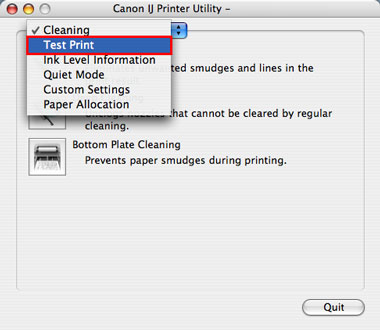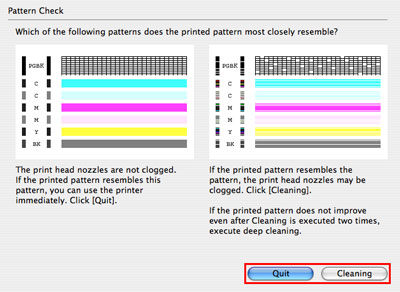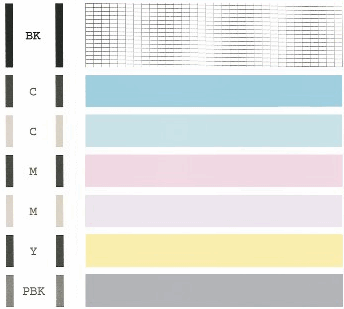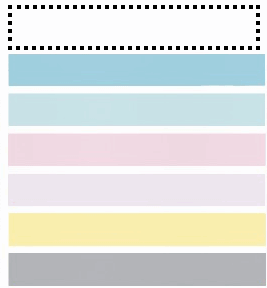Clean The Print Head Nozzles (Mac OS X)
The following contains instructions to check the nozzles for poor print quality and perform cleanings of the print head nozzles as necessary. If print results are faint or streaks are printed, the print head nozzles may be clogged. Those phenomena can be improved by performing print head cleanings or print head deep cleanings.

Caution: Only used the approved methods below to clean the print head. Use of other methods may further clog the nozzles on the print head and may cause permanent damage the print head.
Note: It is important to check the cleaning results by printing Nozzle Check Pattern after each cleaning. Cleaning and Deep Cleaning consumes a certain amount of ink. Only perform a cleanings when necessary.
Print a Nozzle Check Pattern
- Confirm that the printer is connected to the computer and the printer is turned on.
Note: If the remaining ink level is low for any of the ink tanks , the nozzle check pattern may not be printed correctly. Replace the ink tank whose ink is low.
-
Complete or cancel any print jobs in progress, and then launch the IJ Printer Utility
- Launch IJ Printer Utility.
Note: In versions of Mac OS X older than 10.4, open the IJ / BJ Printer Utility from the Library>Printers>Canon>BJPrinter>Utilities folder.
- In the Apple menu select System Preferences
- Open Print & Fax.
- Make sure the correct printer is selected and, depending on OS version, click 'Open Print Queue...' or 'Print Queue...'.
- Click the Utility / Printer Setup icon.
Note: In Mac OS X 10.6, select 'Utility' at the top of the screen, and then click the 'Open Printer Utility' button.
- Select the printer from the list, then click 'Maintenance'.
- From the pop-up menu, select 'Test Print'.

Note: The layout varies depending on the printer and version of OS X you are using.
- Click the 'Nozzle Check' icon.

- Insert a piece of letter-sized plain paper in the paper cassette.
Important: The Nozzle Check Pattern can only be printed on paper loaded into the Cassette. It is not possible to print the Nozzle Check Pattern from the Front Tray or the Rear Tray.
- Click 'Print Check Pattern' on the computer.
Memo: By clicking 'Initial Check Items' before clicking 'Print Check Pattern', you can see the specific confirmation items in Nozzle Check. (Nozzle check pattern printing will start.)
- Examine the Nozzle Check Pattern output.
- Determine whether the pattern is normal or not normal.
- Click here if the pattern is normal.
- If the pattern is not normal, perform a Print Head Cleaning.
Note: Perform this step first to clean the print head.
- If the pattern is not normal after two Cleanings, perform up to two Deep Cleanings of the print head.
Caution: Cleaning consumes a certain amount of ink. Perform cleanings only when necessary.
When the output is normal
- The print head is performing as normal and cleaning is not required. Click 'Quit' to finish the pattern check and exit.
Perform a Cleaning of the print head:
- Click 'Cleaning' to perform print head cleaning.

Note: The pattern varies depending on the printer you are using.
- Select the target ink for cleaning and click 'OK'. (The power lamp will blink green and cleaning of the print head nozzles starts. The blink stops when the cleaning is over.)
Caution: To prevent interruption in the Cleaning process, do not try other operations until the Cleaning completes. Cleaning will take about 40 seconds.

Note: This screen varies depending on the printer you are using.
Note: When performing Cleaning for all colors, check 'All Colors'. When performing Cleaning for Black only, deselect 'All Colors' and check 'Black'. When performing Cleaning for Color only, deselect 'All Colors', and check 'Color'.
Caution: Cleaning consumes a certain amount of ink. Perform Cleaning only when necessary.
- Print a Nozzle Check Pattern and examine.
- Perform Cleaning again if necessary.
Memo: If the pattern is still abnormal after two Cleanings, perform Deep Cleaning.
Perform Deep Cleaning of the print head
Caution: Deep Cleaning consumes a larger amount of ink than normal Cleaning. Perform Deep Cleanings only when necessary.
- From the pop-up menu, select 'Cleaning'.

Note: The layout varies depending on the printer you are using.
- Click 'Deep Cleaning'.

- Select the target ink group for Deep Cleaning and click 'OK'. (The Power lamp will blink green and Deep Cleaning starts. The blink stops when Deep Cleaning is over.)
Note: When performing Deep Cleaning for all colors, check All Colors. When performing Deep Cleaning for Black only, deselect 'All Colors', and check 'Black'. When performing Deep Cleaning for Color only, deselect 'All Colors', and check 'Color'.
Caution: To prevent interruption in the Deep Cleaning process, do not try other operations until Deep Cleaning completes. Deep Cleaning will take about 75 seconds.

Note: This screen varies depending on the printer you are using.
- Print Nozzle Check again.
Note: If the printed pattern is still not normal, perform steps 1 through 4 of the Deep Cleaning process one additional time.
Caution: If after Deep Cleaning the Nozzle Check Pattern is still not normal, turn the printer off and let it sit for 24 hours or more before attempting another Deep Cleaning again. The wait time may allow dried ink in clogged print head nozzles to liquefy, and resolve the problem.
When the output is normal:
- Black ink: The grid pattern is regular without missing lines.
- Color ink: White streaks are not visible in the pattern.

Note: The pattern varies depending on the printer you are using.
Click here to return to step 6 of the Nozzle Check instructions.
When the output is not normal:
- Case A: No color is printed. (Nothing appears on the output.)
- Case B: There is any color that is not printed at all. (In the sample below, black ink is not printed at all.)

- Case C: There are missing lines partially in the pattern for the black ink.

- Case D: There are white streaks in one of the color ink patterns.

Click here to perform print head cleaning.